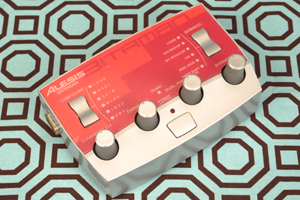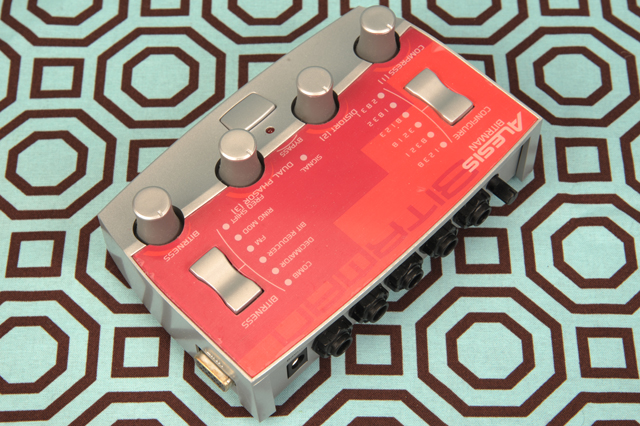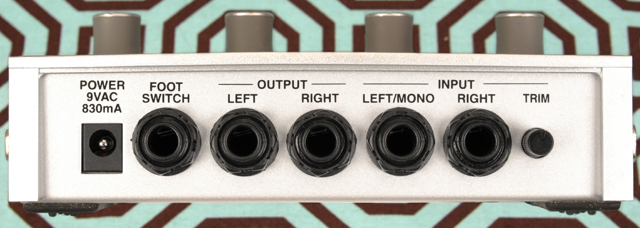
Considered a must-have by many sonic explorers, the Alesis Bitrman collects elements of four different effects: Compressor, Distortion, Phasor and the elusively named Bitrness (a motley assortment of six related, yet uniquely weird signal morphing effects but more on that later). The Bitrman, part of the now discontinued ModFX line introduced in the early 00’s also included the Ampliton (tremolo/autopan), Faze, Phlngr, Philtre, Metavox (vocoder) and Smashup (compressor) al l very much digital units, 24 bits of lossless signal. These weren’t the typical sterile digital of the 80’s but the tweaked beat, filter sweeping, scalable digital of the late 90’s/early 2000’s. Effortlessly traverse Chemical Brothers or Atari Teenage Riot territory, remix to your heart’s content or decimate entire soundscapes.
Because the enclosures are plastic with small non-true bypass buttons ModFX are better suited for use in the studio, on a table/synth top or using Alesis’ proprietary rack mount module rather than affixed to a pedalboard. While not widely embraced upon release those willing to think outside the traditional effects box found at least one of the ModFX units to be quite the creative aide-de-camp. These units introduced many forward thinking sound sculpting options which at the time more frequently resided in software plugins or synthesizers than in a handy little box. A particularly cool innovation that allowed multiple ModFX effects to be combined and controlled in a myriad of ways was the introduction of a 9-pin connector on either side of the units which synced the effects with no additional patch cables and no signal loss. The units also sport stereo in and outs. I highly recommend using the stereo outs at least once. Especially if you think you’ve exhausted the possibilities of this device.
Now, the important thing to remember about the Bitrman is that it is not a multi-effect unit in the traditional sense. The Compressor, Distortion, Phasor or Bitrness were not intended to be used as standalone effects. They will not assist you in your quest to attain classic sounds of yore. That said, the Bitrman is truly greater than the sum of its parts, versatile when embraced on its own terms. Despite each effect really only having one parameter to control, which in most cases goes from off to the extreme, it is how these controls interact with each other or how the effects are ordered is what makes this unit special. The Bitrman Configure switch allows quick reordering of the effects chain providing a dramatic influence on how the controls respond. Go from Comp, Distort, Phasor, Bitrness to Distort, Bitrness, Phasor, Comp with the touch of a button.
Compression adds gain and sustain to quite bits as louder bits get squashed down. Distortion adds a sordid mix of pleasing amp like harmonic distortion and abrasive digital non-harmonic distortion. On its own the single Phasor control knob merely increases the rate of the sweep as it travels clockwise. But the Phasor in particular excels when used in stereo. Dual Phasor! The right and left channels are separate and offset from each other. Things can get wiggly and confusing but there are also some breathtaking swirling vistas to behold. Seriously, just plug in another amp already. Is your mind blown yet? Ok good.
Now, let’s talk Bitrness. Here’s where you can really manipulate and butcher whatever you choose to pump into the Bitrman, be it guitar, bass, keys or drum machine.The six degrees of Bitrness are best heard in action to fully appreciate but here is a quick rundown:
- Comb Filter –an equalizer of sorts, with steep notches in the frequency response. Unlike its Bitrness brethren, when this option is selected it is always in the signal path. Only the frequency filter not the amount are controllable.
- Decimation –a mix of distortion and modulation that adds strange aliasing and ring modulator like effects. As the effect is increased the original signal is submerged completely in the distortion. The folks at Alesis recommend decimating your drum machine. I would have to agree.
- Bit Reducer-This is distortion and limiting to the MAX! It reduces the digital resolution from 24 bit incrementally down to 1 bit. Increasing noise while decreasing dynamic range. At higher levels the input signal will sputter and cut out. 8 bit Nintendo freak outs anyone?
- Frequency Modulation –from watery vibrato sounds at lower settings to touch tone telephone clangs.
- Ring Modulation –Takes the input signal multiplies it with an internal sine wave, giving you the sum and difference frequencies. Vibrato effects, electronic bells or just plain robot gibberish. Some interesting stereo effects can be created when using two amps.
- Frequency Shifting –similar to ring modulator but instead of the sum & difference, you just get the sum. The original input signal eliminated altogether.
Things to keep in mind, the Bitrman needs AC power. Use the correct power supply. Don’t add this to your daisy chain you may regret it! Don’t go stompin and a hoppin on these ModFx units. They will break! However, there is a footswitch jack on the back. Simply connect a more pedalboard friendly switch if you plan to use this guy live. When the bypass LED is lit up the unit is on. These units favor line level signal so when using a guitar don’t be alarmed if there is some hiss or if the peak of the Phase wave overloads your amp(s).Trim pot on the back will help even things up but yeah, that hiss can be tiresome. When the unit is engaged there can be a noticeable pop when selecting a different Configuration or Bitrness. But the brave soul that explores the Bitrman will be rewarded by everything from circuit bent mayhem, aggressive synths, klaxon whispers of cyborg specters to watery expanses beyond compare.


FROM OUR REFERENCE SECTION:
Price: $N/A
Manufacturer: Alesis
Voltage: 9VAC
Dimensions: 5.8" X 3.9" X 2.1"
Color: Red and Grey
